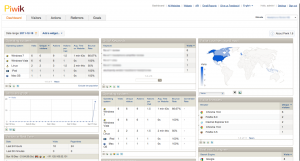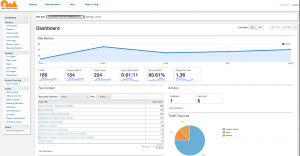
Alternatives to Google Analytics
I’m a believer in Google’s tools and I believe you should leverage as much as you can, especially if it’s free. Unfortunately, Google’s tools aren’t “free” as they are collecting as much information as they possibly can about your site and its visitors. I’ve already got Adsense hooked up to several of my niche sites and I have no doubt Google is tracking as much as they possibly can based off the ads alone. Giving Google the keys to all my user analytics just bothers me for some reason. As a matter of fact, just about anything that’s stored about my site hosted completely on external servers kinda bothers me. I like to own my data, simple as that. So, for that reason, I’ve put together a list of analytics software that is free to use a
Piwik Open Source Analytics – http://www.piwik.org/
Piwik’s analytics resemble Google’s analytics very closely and if you’re familiar with the aforementioned, you’ll be more than at home with Piwik. First, let’s start with the Piwik Dashboard. This is similar to what you”ll see when you log into Google Analytics. Everything in the dashboard is a widget, meaning you can add, remove and rearrange your widgets in any way you see fit. The beauty behind this is that just about everything you can look at by going to a primary tab or a sub tab inside Piwik is a widget. So if you want to see more detailed data on your dashboard, all you have to do is find out which page you’re wanting to see and just add a widget on the dashboard. This is all very simple to do and extremely effective. Another beauty of the widget interface is that Piwik is open source and they provide the API to develop your own widgets. If you find that you’d like to see the data in another way, you OWN the data yourself, you have the API, and you can create your own widget that can be plugged into the Piwik interface.
I love the interface as it’s very minimalistic with clean lines and the data/charting is where the focus is. The aggregation of data seems to be spot on (I’ll touch on that further below when I talk about Open Web Analytics), and the user interface is very simple to navigate. Another thing worth mentioning is that Piwik’s interface is very AJAX centric meaning that they pull back minimal amounts of data at first so the interface is snappy and additional drill down information is typically only a click away. The extra detailed information is actually one thing I found that I liked about Piwik much more than Google Analytics. There are certain things that I click on in Google Analytics that seem like they should drill further into the details and they just take you to a page with that one item.
Another thing I want to mention that I really like is that Piwik makes it very easy to remove yourself from showing up in your analytics results. There’s an option inside the settings section that allows you to set a cookie that will tell Piwik to ignore your browser – you can even delete the cookie if you want to later include your page views in their tracking. Piwik also makes it very easy to skip tracking for IP addresses either for all your sites for one site at a time.
Finally, what makes Piwik stand out in my opinion is just how stable it is. All the data appears when and where I expect it to show and I never feel like something is wrong with what I’m looking at. Everything is well laid out and accurate as far as I can tell – I ran this and Open Web Analytics on one site all at the same time along side Google Analytics just to ensure I was getting quality results from the three. I am actually going to keep the three running for about a week or two just to ensure everything is kosher.
Piwik Conclusion – My favorite Google Analytics Alternative – HIGHLY RECOMMENDED
Open Web Analytics – http://www.openwebanalytics.com/
Open Web Analytics is another real time site tracking analytics package that is similar in function to Google Analytics. This particular analytics package looked like it was literally trying to take the look and layout of Google Analytics and replicate it. The dashboard in Open Web Analytics looks almost identical to what you’d see inside Google Analytics. So, needless to say, if you like the blues that Google throws into all their free tools, you’ll be right at home with this.
Just like Google Analytics and Piwik, this is also a real-time analytics software package so you can refresh every 10 minutes if you’d like and see all the new visitor information from your site.
So I’ll start off with the navigation and the overall interface layout – while it’s not terrible, it just doesn’t seem as well thought out as Piwik. Again, they copied Google Analytics layout almost verbatim. The navigation is down the left side of the page and everything is categorized by Visitors, Content, Traffic, etc. It’s not that it’s all that bad, but after using Piwik, everything just seemed better laid out. That’s really a personal preference and I’m sure everyone will have their own opinion on that. My one real complaint with this though is it seems to be similar to Google Analytics in the respect that some items that you click on just don’t seem to take you anywhere relevant. If you’re going to make something a link, take me somewhere worthwhile!
I briefly mentioned in the Piwik section above that the data is aggregated well. Let me explain what I meant by that. The Open Web Analytics does a good job of recording all visits. What it doesn’t do all that well though is aggregate data from search engines all that well. Where Google Analytics and Piwik might state that you had 50 visitors from Google searches, Open Web Analytics might show you that 10 came from google.com. Then it might show you that 3 came from google.co.uk and then another 5 from google.ca. You get the point. I’m actually a little torn on this. It’s nice to know where your traffic is coming from, but in Piwik, there’s another widget for that. I think in most cases I’d rather see the search engines rolled up into one “google” rather than the 10 or 15 separate ones that I see in Open Web Analytics. So again, this is a pick your flavor type of thing.
Now, onto the star of the show. There’s one feature in Open Web Analytics that will keep me using it, regardless of whether I even look at the analytics data. They have a “dom streamer” function that allows you to actually record how a user interacts with your web page. When I say it records, it’s not a true recording, rather it’s small bits of data sent back to the server whenever a user is interacting with your webpage. If a user is scrolling, clicking, etc. that information can be stored so you can see exactly where a user went on the page, what they clicked, what the moused over, you get the idea. When it works, this is some of the best research you can get when trying to improve conversion rates on your pages. For instance, on one of my review sites, it’s very common for people to scroll straight to the bottom to see my conclusion, and if it’s a favorable one, then they’ll scroll up to find out the details of why I gave it this rating. It’s very interesting to see how people interact with your pages – it can be an eye opening experience to say the least. Now, the caveat is that it doesn’t always seem to work. I don’t know how to explain this other than sometimes I’ll go to watch the event and it won’t do anything. Other times everything I open up works fine. I’m starting to believe that if the server is under any kind of load at the time I’m trying to view the playback of the user activity that it just flat out won’t load. I’ll investigate this more and update this when I find something concrete out. Again, this feature alone will keep this analytics package on my sites. When it works, it’s literally invaluable.
One last thing I’d like to point out is that if you’re using WordPress (and I think other platforms) there is an included plugin so that you can view your analytics right inside your WordPress administration section. This is definitely a nice to have, but not all that necessary. Essentially it’s the entire OWA interface inside WordPress – it’s identical to what you’d see if you went straight to your primary install interface.
Open Web Analytics Conclusion – Has Features I Can’t Live Without – Recommended for the Dom Streams
Overall Conclusion and What I’m Doing
Ok, so now that I’ve given you a very basic overview of what I like/dislike about the above options, you can clearly see that I love the Piwik analytics package. By far it’s my favorite of the three. However, Open Web Analytics includes a Dom Stream recorder that is simply gold when utilized to identify how users actually interact with your website. I’m currently running all three analytics packages on my site and I’m not seeing any slowdown. With that being said though, I fully plan to remove Google Analytics in about a week or two just after I gather some more data for comparison sake. Once I get rid of Google Analytics, I might see how I can reduce the amount of data stored in Open Web Analytics because all I really care about is the dom streams.
One final thought – site visitor analysis, for a popular site can balloon the data up pretty quickly. Each user visit is broken down and stored in several different database tables in various levels of aggregation – so one row turns into many other rows in a database. For this reason, you’ll probably want to make sure you stay on top of the size of your database and set up a cron job or other monitor to make sure you keep your database at a reasonable state. It might be worth archiving and downloading copies of the data in your database every month and getting it off your primary host. That way you can keep your web server running light on its feet.
Go get your copies of Piwik and Open Web Analytics today to try out for yourself. They’re free and simple to install, so they’re both definitely worth trying out. If you decide you don’t like one or the other, all you have to do is delete the folder and the database and you’re good to go.
If you find this information useful, or if you have any questions or comments, leave them below.

